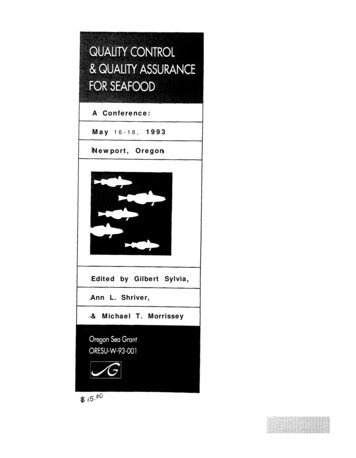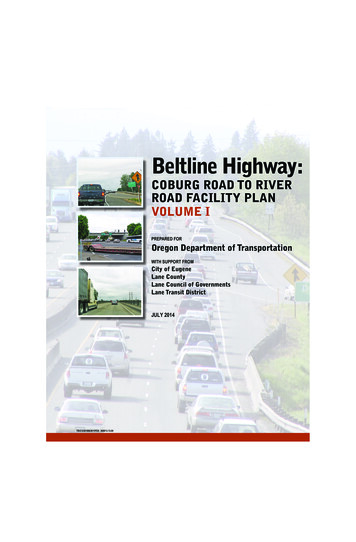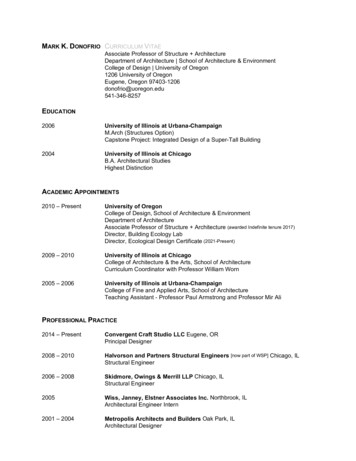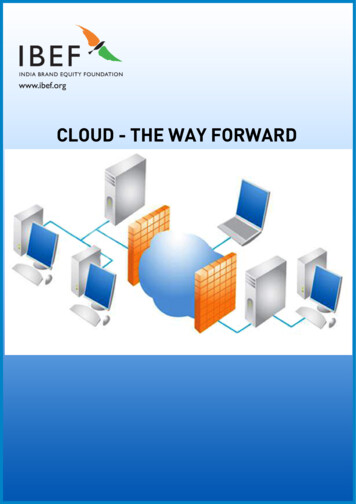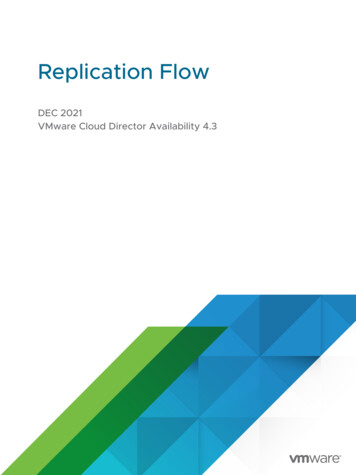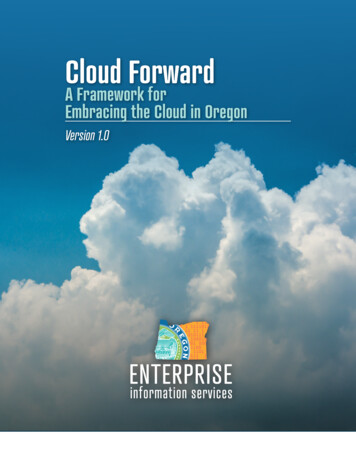
Transcription
Cloud ForwardA Framework forEmbracing the Cloud in OregonVersion 1.0Cloud Forward - A Framework for Embracing the Cloud in Oregon Version 1.0
Cloud ForwardA Framework for Embracing the Cloud in Oregon – version I. OVision.Oregon will strive to conduct 75% of its business via cloudbased services and infrastructure by 2025–leveraging theseplatforms to modernize state IT systems and make Oregon aplace where everyone has an opportunity to thrive.Cloud Forward – Guiding PrinciplesCloud-First. Cloud will be the first and preferred option for all new IT investments. It shouldnot be conflated with the idea of “cloud everything.”Agility Counts. Cloud migration decisions will be driven by considerations of business agilityand overall cloud value, in addition to considerations of cost, time, effort and risk.Saas, please. Software-as-a-Service (SaaS) will be the preferred cloud tier and be evaluatedbefore other cloud tiers (i.e., PaaS or laaS) or migration models.Lift-and-Shift Last. As a migration strategy, re-hosting or “lifting and shifting” provides little(if any) cloud value or cost savings. Re-hosting should only be considered as last resort.Multicloud. Embracing multicloud positions the state to leverage the unique value propositions and capabilities offered by leading cloud service providers.Upskilling. As a state we are committed to upskilling our existing IT workforce and preparingthem for a cloud-defined future.Business Enablement. Embracing the cloud frees up IT organizations from having to man-age traditional IT infrastructure and operations tasks and provides opportunities to enable theirbusiness and program units through strategic use of data, business intelligence, integrations, andagile development.
Table of ContentsExecutive Summary . 2Cloud Forward – Vision and Alignment . 3Cloud Forward – Guiding Principles . 4Cloud Forward – Business and Technical Benefits . 4Business Benefits . 4IT Benefits . 5Cloud Forward – Assumptions . 5Cloud Forward – Organizational Impact . 6Cloud Forward – Workforce . 7Business Processes . 8Cloud Forward - Decision Framework. 10Cloud-First . 11Secure Cloud by Design . 11Data Governance and Information Management . 12Enterprise Application and Cloud Utilization Assessment . 12Application Migration Models . 13Cloud Tiers . 15Multicloud . 15Workload Placement. 16Enterprise Cloud Brokerage Services . 17Conclusion . 18Appendices . 19A. Essential Characteristics of Cloud Computing . 19B. Cloud Deployment Models . 19C. References . 201
EXECUTIVE SUMMARYThe purpose of Cloud Forward—A Framework for Embracing the Cloud in Oregon is to define andcommunicate the Enterprise Information Services (EIS) cloud vision and to enable state agencies toaccelerate cloud adoption across the Enterprise. Consequently, the scope of this document is limited toguiding principles, critical decision points, and cloud migration approaches and methodologies. Theframework will be further elaborated through the establishment of cloud governance, detailedimplementation planning, development of agency cloud adoption toolkits, and realignment of existingEIS policies and oversight processes.Figure 1. Cloud Forward in ContextSince the advent of cloud computing in 2006 when Amazon Web Services (AWS) first offered ElasticCloud Compute and nearly a decade since the publication of the 2011 Federal Cloud Computing Strategy(“Cloud First”), innumerable local, state, and federal agencies, as well as countless private-sectorcompanies, have embarked on their cloud adoption journeys. 1 Since then, the cloud market hasmatured, become increasingly competitive and best practices in cloud migration and management haveemerged. The 2019 revised Federal Cloud Computing Strategy (aka “Cloud Smart”), is a case in point, asit provides valuable insights on the importance of security, procurement, and workforce in acceleratingcloud adoption; albeit within the context of the federal government. 2 Given these developments, theState of Oregon is uniquely positioned to embrace best practice and apply lessons learned, whiletailoring them to the needs of Oregonians in working to realize our Cloud Forward vision.Vivek Kundra, “Federal Cloud Computing Strategy” (Office of Management and Budget, February 8, 2011).Suzette Kent, “Federal Cloud Computing Strategy” (Office of Management and Budget, June 24, 2019),https://cloud.cio.gov/strategy/.122
Cloud Forward – Vision and AlignmentNow more than ever, people rely on the State of Oregon to provide essential services that keep themhealthy and safe and enable them to live fulfilling lives. Whether enrolling for healthcare orunemployment benefits, tracking student’s progress in school, or effectively managing a public healthcrisis, effective service delivery increasingly demands modern, user-friendly, reliable, and secure stateinformation technology (IT) systems. 3To realize this vision, Enterprise Information Services (EIS) is adopting Cloud Forward—A Framework forEmbracing the Cloud in Oregon, wherein the state will strive to conduct 75% of its business via cloudbased services and infrastructure by 2025—leveraging these highly-scalable, resilient, and elasticinfrastructure and technology platforms to modernize state IT systems and make Oregon a place whereeveryone has an opportunity to thrive. This vision aligns with strategies outlined in the Governor’sAction Plan for IT, User Friendly, Reliable, and Secure: Modernizing State Information TechnologySystems and Oversight and the EIS Strategic Framework 2020-2023, Version 1.0. 4While the state has and will continue to realize value from its long-term investment in Data CenterServices (DCS) as a provider of managed compute services and future co-location offerings (i.e., privatecloud), the State of Oregon’s current physical IT infrastructure alone lacks the agility, scalability,resilience and cloud-native capabilities necessary to meet the emergent and future needs of Oregonians.Beyond the inherent advantages of the cloud, Cloud Forward provides opportunities to limit the needfor long-term capital expenditures (e.g., lifecycle replacement), reduce technical debt, lay thefoundation for the modernization of state IT systems, and establish IT as a broker of cloud and ITservices.Key objectives of Oregon’s Cloud Forward framework include: A cloud-first approach for all new IT investments;Improve operational and business agility by enabling the State of Oregon to react to federal,state, and business changes more quickly and deploy cloud-native capabilities;Improve workforce productivity through access to cloud services and mitigating the delay toacquire timely environment access;Reduce operational costs for new and re-factored applications through cloud infrastructureefficiencies that enable supply and demand for environments and employ elastic cost base andtransparency;As part of Oregon’s Cloud Forward strategy and implementation, EIS will establish a Cloud Center ofInnovation (CCOI) and Cloud Services Advisory Council (CSAC), deploy enterprise services in the cloud(e.g., Microsoft 365), invest in cloud enablement capabilities at DCS, and ensure that Executive Branchagencies adhere to the guiding principles and decision framework that follows.Kate Brown, Nik Blosser, and Terrence Woods, “User-Friendly, Reliable and Secure: Modernizing StateInformation Technology Systems and Oversight” (State of Oregon, September 24, 2018).4Brown, Blosser, and Woods; Terrence Woods, “EIS Strategic Framework 2020-2023, Version 1.0” (State ofOregon: Enterprise Information Services (EIS), n.d.).33
Cloud Forward – Guiding PrinciplesCloud Forward—A Framework for Embracing the Cloud in Oregon is built around the followingprinciples.Cloud-First. Cloud will be the first and preferred option for all new IT investments. It should notbe conflated with the idea of “cloud everything.”Agility Counts. Cloud migration decisions will be driven by considerations of business agility andoverall cloud value, in addition to typical considerations of cost, time, effort and risk.SaaS, please. Software-as-a-Service (SaaS) will be targeted as the preferred cloud tier andshould be evaluated before other cloud tiers (i.e., PaaS or IaaS) or migration models.Lift-and-Shift Last. As a migration strategy, re-hosting or “lifting and shifting” provides little (ifany) cloud value or cost savings. Re-hosting should only be considered when there are no otherfeasible alternatives or there are compelling reasons to do so; e.g., urgent need to migrate anda lack of data center capacity.Multicloud. Embracing multicloud acknowledges both the current reality and the unique valuepropositions and capabilities offered by leading cloud service providers.Upskilling. As a state we are committed to upskilling our existing IT workforce and preparingthem for a cloud-defined future.Business Enablement. Embracing the cloud frees up IT organizations from having to managetraditional IT infrastructure and operations tasks (i.e., “keeping the lights on”), and providesthem with an opportunity to enable their business and program units through strategic use ofdata, business intelligence, integrations, and agile development.Cloud Forward – Business and Technical BenefitsAs part of the Cloud Forward framework, EIS and state Executive Branch agencies have adopted andcommitted to the principle of cloud-first. Cloud will be the first and preferred option for all new ITinvestments. Where compelling reasons exist to not use cloud computing, Executive Branch agencieswill be strongly encouraged to use DCS private- and hybrid-cloud managed and co-location services. Theaccelerated adoption of cloud services will generate many business- and technical-related benefits toExecutive Branch agencies, both in terms of service delivery and IT capacity:Business Benefits 4Agility. Empower agencies with greater agility in dealing with legislative mandates andunanticipated or novel service demands—enabling them to rapidly innovate, develop, test, andadapt new applications and service models within no-code or low-code, cloud-baseddevelopment environments with lower initial costs;
Resilience. Employ redundant, modular, durable, and secure cloud architectures to improve theavailability and resiliency of critical services when people need them most; Scalability. Scale new or existing services in real-time in response to sudden increases or shiftsin demand; Security. Leverage world-class information security capabilities of cloud service providers (CSPs)and automated, policy-based cloud backup services that ensure data availability and protectionagainst ransomware and other cyber threats; Innovation. Deploy current and emergent cloud-native services such as big-data analyticsmachine learning, artificial intelligence (AI), internet of things (IoT) and high-performancecomputing (HPC) to enhance existing services and innovate new ones; IT Value. Embrace cloud cost transparency, asset accountability, and elastic cost models (i.e.,“paying for what you use”), eliminate wasteful overprovisioning as a form of capacitymanagement and achieve cost savings by deploying cloud-native applications, reducing thestate’s overall IT infrastructure footprint, limiting future capital investments and avoidingtechnical debt.IT Benefits IT Management. Enable self-service provisioning, leverage cloud management capabilities,orchestration, and cloud automation to handle repetitive, error-prone administration tasks andeffectively manage dynamic workloads, and eliminate physical supply chain constraints andtechnical debt associated with the management of IT physical infrastructure; IT Staffing. Increased productivity from existing IT personnel by shifting them towards highervalue tasks versus managing physical hardware. Embracing the cloud will free up ITorganizations from having to manage traditional IT infrastructure and operations tasks (i.e.,“keeping the lights on”), and provides them with an opportunity to enable their business andprogram units through the strategic use of data, business intelligence, integrations, and agiledevelopment within no-code and low-code dev-ops environments.Cloud Forward – AssumptionsEmbracing the cloud in Oregon and working to realize the vision of Cloud Forward is an ambitiousagenda for both agency and IT leadership alike—it is an opportunity to reimagine the way that we defineand deliver services to the people of Oregon. As we embark on building a cloud-defined future inOregon, the importance of sustained leadership and commitment to agency modernization cannot beunderstated. At the same time, however, it is important to acknowledge that this vision will requiresustained capacity, sufficient resourcing, commitment to Cloud Forward’s guiding principles, and theability to navigate organizational change.5
CLOUD FORWARD – ORGANIZATIONAL IMPACTOregon’s Cloud Forward framework has the potential to transform how state agencies manage IT andenable the delivery of services to the people of Oregon, with far-reaching organizational implications forboth IT and agency leadership in terms of people, processes, and technologies. Given the nature andbreadth of service offerings and capabilities available via cloud service providers, innumerableconfiguration options, and opportunities for self-service provisioning, successful implementation ofCloud-First will require the creation of new governance and organizational structures, the developmentand maturation of new skillsets, roles and capabilities within EIS and agency IT divisions, and a shifttowards IT as a broker of cloud services. Throughout this transformation, EIS will provide changeleadership and commit to embracing new ways of doing things. EIS plans to:6 Establish a Cloud Center of Innovation (CCoI). Lead by a Cloud Architect and supported by ateam of dedicated Cloud Engineers with ready access to domain-specific expertise throughoutEIS, the CCoI will become the state’s primary repository for cloud expertise, knowledge, andcloud management tools. Cloud Engineers will have experience across multiple IT silos, gaindeep knowledge of the service offerings and configurations available from different CSPs, beable to design successful cloud solutions, and facilitate the migration of existing workloads. TheCCoI will also work to ensure that the necessary operational processes and tools are in place tomanage and monitor operations across hybrid- and multi-cloud environments (i.e., costmanagement, template repository, utilization, and performance, workload orchestration, andself-service portals). Establish a Cloud Services Advisory Council (CSAC). The CSAC will be established as asubcommittee of the Enterprise IT Governance Committee (EITG). It will be co-chaired by acurrent member of EITG and the State’s Chief Technology Officer. Its voting membership willinclude agency business and IT representation from the six policy area verticals. Additionally, itwill have advisory representation from the DAS Chief Financial Office, DAS Procurement, and theChief Human Resources Office. The Council will be responsible for providing the CCoI withstrategic direction in implementing this strategy, serving as an escalation point for decisionswith cross-agency or significant impact, and making recommendations to EITG on all policiesrelated to cloud computing. Establish DCS as a broker of cloud services. The role of DCS as a services broker is to enableagency IT divisions, developers, and end-users to quickly access and deploy cloud environmentswith minimal friction and IT overhead while maintaining effective guardrails in terms ofcentralized policies and procedures that leverage pre-built templates. This represents afundamental shift from the traditional approaches to providing centralized IT infrastructure, andit requires a close partnership with the CCoI in vetting, implementing, adopting, and making newcloud solutions available. As the brokering function matures, end-users will be increasingly ableto leverage self-service portals.
Cloud Forward – WorkforceAs Oregon moves towards a cloud-defined future where the traditional aspects of IT infrastructuremanagement, networking, computing, and service delivery are abstracted from physical hardware anddefined in code, it will require both new skills and new ways of thinking about the IT profession. Newroles will need to be established and existing IT roles will need to be enlarged to encompass the uniqueskills required to manage cloud-based services.To this end, EIS will partner with the DAS Chief Human Resources Office and Executive Branch agenciesto develop a roadmap for building and retaining a cloud-ready workforce—leveraging vendor-specificcloud certification programs and training to “skill up” up our existing IT workforce and hiring for criticalskills gaps when necessary. These single- and multi-day certification programs, training courses, andcertification exams will be critical to our transformation and will require the requisite investment of stafftime and resources.Given that the development of a cloud-ready workforce will take time, EIS and Executive Branchagencies will also leverage outside consulting and staffing resources as necessary during the initialimplementation of this strategy.In working to develop a cloud-ready workforce, EIS envisions the establishment of the following roles,including cloud architects, cloud engineers, cloud account and relationship managers, and cloudapplication developers.Cloud Architects with an enterprise focus will: Configure guardrails, blueprints, and policy to assure security, consistency, andcompliance Assure business alignment with cloud capabilities Foster a shared services culture Provide workload placement assessments Design for resiliency, business continuity, and auditabilityCloud Engineers, Security, and Operations Analysts will: Plan, build and run virtual networks Plan, build and run resilient, durable cloud compute and storage Monitor cloud health, performance, and capacity Integrate on-premises and cloud services Assure secure configurations and monitor compliance Provide backup and recovery servicesCloud Account and Relationship Managers will: Perform cloud billing and cost management Assist customers with consumption-based billing estimates Partner with members of the Basecamp IT Supply Chain Management initiative onprocurement and contracting, enterprise licensing, vendor relationship management,and vendor performance managementCloud Application Developers will: Develop new applications leveraging functions, containers, and event hubs Migrate existing applications to database and runtime services7
Automate build and run tasksDevelop capabilities based on cloud-native technologies such as machine learning andartificial intelligenceAt the same time, our IT workforce must remain cognizant of what constitutes an enterprise-gradeservice as we integrate cloud capabilities into our existing service offerings—ensuring that the sameresiliency, security, compliance, and engineering rigor we apply to our on-premise infrastructuretranslates to our cloud service offerings.Business ProcessesGiven the inherent nature of cloud computing, it will also be necessary for EIS to adapt current businessprocesses in terms of IT procurement, operations, infrastructure provisioning, and IT budgeting and costrecovery.8 IT Procurement and Vendor Management. Self-service and on-demand provisioning areinherent characteristics of cloud computing environments. Dynamic provisioning within ahybrid- or multi-cloud environment coupled with an ever-growing list of cloud-based servicesand capabilities, requires a modern procurement approach and effective vendor andrelationship management. As part of the Cloud-First strategy, EIS will continue to partner withDAS Procurement Services through its engagement as a member of the CSAC and the BasecampIT Supply Chain Management initiative—working to establish the portfolio of contractsnecessary for a cloud-defined future and to mitigate against the risks of vendor lock-in with anysingle cloud services provider. DCS Operations. Current DCS infrastructure services are designed to provision and maintainservices within the state-owned data center. In adapting to a cloud computing model, DCS willinvest in cloud enablement capabilities and establish processes, frameworks, and tools fordynamically managing on-premise, co-location, and cloud computing resources. Initially, DCSwill prioritize the use of native tooling for each cloud service provider within workload-basedsilos. As DCS cloud enablement capabilities mature, it will work to develop dynamic crossplatform cloud management capabilities and tools to enable composite and redundant cloudarchitectures. Infrastructure Resource Provisioning. Historically, when hardware resources were provisionedfor customers at the state data center, DCS sized them for future growth and anticipated peakloads (as has long been common practice within the industry). Consequently, on any given day(i.e., non-peak), these resources may be substantially over-provisioned, and additional expensesare incurred to maintain idle capacity. In moving to the cloud and through applicationmodernization, there will be opportunities to right-size these workloads enabling them to scaleup or down based on demand and reduce the costs associated with over-provisioning. IT Budgeting and Forecasting. Cloud-First has significant financial implications for IT budgetingand cost recovery. Current IT budgeting and rate development are developed as part of thebiennial budget development process—in effect, requiring agencies to forecast demand forparticular service lines up to 3 years in advance with limited visibility into the operational servicecosts at a granular level. At the same time, current DCS rate and assessment models are
premised on predictable capital expenditures (CapEx) for the lifecycle replacement of hardwareevery 3-5 years. In transitioning to cloud computing, relatively-fixed long-term CapEx will beincreasingly replaced by dynamic operational expenditures (OpEx) that may fluctuatesubstantially from one month, day, or even second to the next.Figure 2. Comparing Fixed Capacity Planning (CapEx) versus On-Demand (OpEx) 5Beyond the shift from CapEx to OpEx, cloud services will require new approaches to ratedevelopment, assessment, and billing practices. Current cost recovery practices may have theunintended consequence of discouraging agency cloud adoption among DCS customers ifsavings realized from migrating workloads to the cloud are offset by increased rates andassessments to cover fixed costs associated with the data center. Accelerating agency cloudadoption requires new models of IT cost recovery, realignment of the state’s budgetary andaccounting systems to accurately differentiate cloud expenditures (i.e., ORBITS and SFMS) fromother IT cost centers, increased utilization of pass-through expenditure limitation, the adoptionof dynamic price lists and service offerings and enhanced maturity within the domains of ITService Management (ITSM) and Technology Business Management (TBM). However, thesechanges will require the commitment of Enterprise Leadership and legislative action. Lastly,without a clear understanding of the total cost of ownership (TCO) by application and virtualmachine across the Executive Branch, there is no way to develop a financial comparisonbetween the current- and future-state in the cloud. 6“Cloud Strategy: Communication Deck for Senior Executives,” CEB Infrastructure Leadership Council (CEB(formerly Corporate Executive Board), Gartner, n.d.).6Marco Meinardi, “How to Develop a Business Case for the Adoption of Public Cloud IaaS,” Gartner, CloudComputing for Technical Professionals, November 21, 2018, 47; “The Application Rationalization Playbook: AnAgency Guide to Portfolio Management” (Federal Chief Information Officer (CIO) Council and the Cloud &Infrastructure Community of Practice, n.d.).59
CLOUD FORWARD - DECISION FRAMEWORKSuccessfully implementing the Cloud Forward framework, will require effective decision-making,commitment, and clear alignment between agency and IT leadership. Particularly, as agencies embarkupon their application modernization initiatives, evaluating their application portfolios and developingmulti-year IT modernization plans for retiring legacy systems to improve service delivery. Increasingly,and with few exceptions, application modernization is synonymous with moving to the cloud.Consequently, the decision framework that follows is foundational to the modernization of state ITsystems—it provides a roadmap for the state’s cloud journey by addressing key decision points anddefining the core principles that will inform application- and workload-specific migrations.[4] Given thatthe scope of this document is inherently limited, the decision framework that follows will be furtherelaborated through the establishment of cloud governance, detailed implementation planning,development of agency cloud adoption toolkits, and realignment of existing EIS policies and oversightprocesses—future “decisions” represent unique bodies of work necessary for operationalizing the CloudForward strategy.Table 1. Decision Point Summary10AreaDecision PointCloud-firstWill the state adopt a Cloud-first policy?SecurityHow will the state implement security and privacyrequirements (vulnerability management, access controls )in the cloud?Data Governance andInformation ManagementHow will state agencies govern data and manageinformation in the cloud?Application and Cloud UtilizationAssessmentHow will state agencies assess new and existing applicationsagainst cloud migration and establish a baseline for currentcloud utilization?Application Migration StrategyWhat migration strategies will agencies employ?Cloud TiersHow will state agencies decide between Software as aService (SaaS) and other cloud tiers?Multi-CloudWill the state pursue a multicloud strategy from the start?Workload PlacementHow do we select the best environment for new ITinvestments and existing workloads?Enterprise Cloud ServiceBrokeringHow will EIS enable state agencies to leverage cloudservices?
Cloud-FirstThe State of Oregon is adopting a cloud-first strategy. Cloud will be the first and preferred option for allnew IT investments. In effect, for EIS and Executive Branch agencies, the question will be, “why notcloud”? However, it does not necessarily follow that all existing IT workloads will be migrated to thecloud (a common misconception), rather there is a presumption in favor of the cloud for all new ITinvestments. Cloud-First represents a fundamental strategic shift, as historic use of cloud has largelybeen opportunistic, fragmented, and typically undertaken only as a last resort; e.g., inability to meetinfrastructure requirements within the state data center.Secure Cloud by DesignAs the State of Oregon moves towards a cloud-defined future, there are increasing opportunities toembed risk assessmen
As a migration strategy, re-hosting or “lifting and shifting” provides little (if any) cloud value or cost savings. Re-hosting should only be considered as last resort. Multicloud. Embracing multicloud positions the state to leverage the unique value proposi-tions and capabilitie
